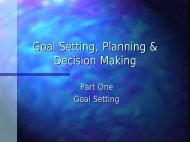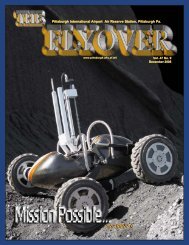March 2007 Flyover internal.pmd - Pittsburgh IAP Air Reserve Station
March 2007 Flyover internal.pmd - Pittsburgh IAP Air Reserve Station
March 2007 Flyover internal.pmd - Pittsburgh IAP Air Reserve Station
- No tags were found...
You also want an ePaper? Increase the reach of your titles
YUMPU automatically turns print PDFs into web optimized ePapers that Google loves.
The <strong>Flyover</strong>News<strong>March</strong> <strong>2007</strong>Daylight Savings Time springs forward <strong>March</strong> 115By National Atlas.govBeginning in <strong>2007</strong>, DaylightSaving Time is extended one monthand begins for most of the UnitedStates at: 2 a.m. on the secondSunday in <strong>March</strong> to 2 a.m. on thefirst Sunday of November.The new start and stop dates wereset in the Energy Policy Act of 2005.This new change will requirecertain computer updates to maintaina computers <strong>internal</strong> clock. Thesepatches can be obtained by setting ahome computer to receive automaticupdates.This problem is not Y2K revisited,but more something a simple updatecan fix.Spring forward...Fall back....It’s ingrained in our consciousnessalmost as much as the A-B-Cs or ourspelling reminder of “i before e....”And it’s a regular event, thoughperhaps a bit less regular than theswallows coming back to Capistrano.Yet in those four words is a wholecollection of trivia, facts and commonsense about Daylight Saving Time.In 2005 and 2006, Daylight SavingTime begins for most of the UnitedStates at 2 a.m. on the first Sundayof April. Time reverts to standardtime at 2 a.m. on the last Sunday ofOctober.This year all that changes with thedates moving up two weeks andpushing Daylight Savings Time fromApril to mid-<strong>March</strong>.Saving Time Saves Energy:One of the biggest reasons wechange our clocks to Daylight SavingTime is that it saves energy. Energyuse and the demand for electricityfor lighting our homes is directlyconnected to when we go to bed andwhen we get up. Bedtime for mostof us is late evening through the year.When we go to bed, we turn off thelights and TV.In the average home, 25 percentof all the electricity we use is forlighting and small appliances, such asTVs, VCRs and stereos. A goodpercentage of energy consumed bylighting and appliances occurs in theevening when families are home. Bymoving the clock ahead one hour, wecan cut the amount of electricity weconsume each day.Studies done in the 1970s by theU.S. Department of Transportationshow that we trim the entirecountry’s electricity usage by aboutone percent EACH DAY withDaylight Saving Time.Daylight Saving Time “makes” thesun “set” one hour later and thereforereduces the period between sunsetand bedtime by one hour. This meansthat less electricity would be used forlighting and appliances late in the day.We also use less electricitybecause we are home fewer hoursduring the “longer” days of spring andsummer. Most people plan outdooractivities in the extra daylight hours.When we are not at home, we don’tturn on the appliances and lights. Apoll done by the U.S. Department ofTransportation indicated thatAmericans liked Daylight SavingTime because “there is more light inthe evenings therefore, we can domore in the evenings.”While the amounts of energysaved per household aresmall...added up they can be verylarge.In the winter, the afternoonDaylight Saving Time advantage isoffset by the morning’s need for morelighting. In spring and fall, theadvantage is less than one hour. So,Daylight Saving Time saves energyfor lighting in all seasons of the yearexcept for the four darkest monthsof the year (November, December,January and February) when theafternoon advantage is offset by theneed for lighting because of latesunrise.
















